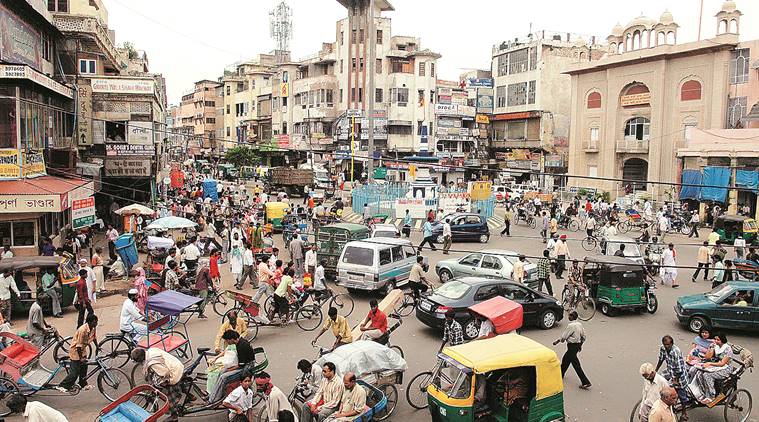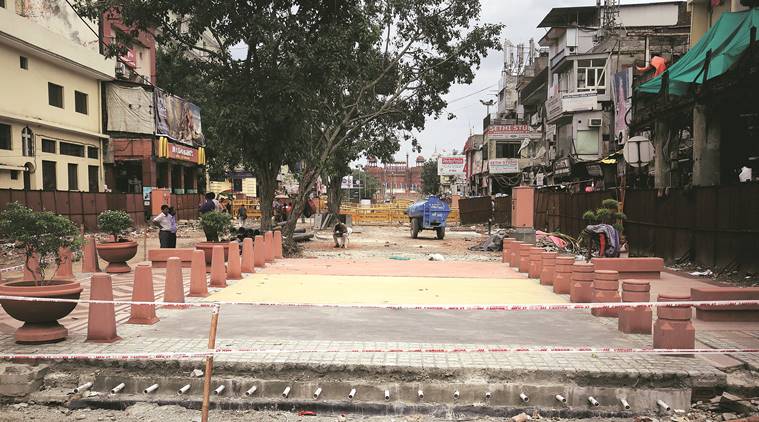- India
- International
Chandni Chowk 2.0
No cars, pathways lined with trees, and red sandstone benches — by March 2020, a 1.3-km stretch in Chandni Chowk will sport a new look. The Indian Express explores how a redevelopment project is updating one of Delhi’s busiest and oldest markets.
 In December last year, Deputy Chief Minister Manish Sisodia launched the project and stakeholders — from shopkeepers to residents — were brought on board. Then, the digging began. (Express photo by Praveen Khanna)
In December last year, Deputy Chief Minister Manish Sisodia launched the project and stakeholders — from shopkeepers to residents — were brought on board. Then, the digging began. (Express photo by Praveen Khanna)
Between Red Fort and Fatehpuri Masjid stands the idea of a new Chandni Chowk — one that looks towards a car-free future, and looks back at a Mughal aesthetic. The Delhi government’s ambitious Rs 65-crore Chandni Chowk Redevelopment Project is underway, and with a 12-metre sample ready, chatter in the area has touched a crescendo.
“Naamumkin ko bhi mumkin kar diya hai,” said a 38-year-old shopkeeper, taking a break from work to take photos of the “sample of New Chandni Chowk” for his family WhatsApp group. A woman looking for a famous wedding lehenga store stopped to inquire if work will be done by next year, while a visitor at the Sisganj Gurdwara suggested that the carriageway be painted in the colour of the Red Fort. After a 15-year delay, the redevelopment project, which will cover a 1.3 km stretch, doesn’t seem like a distant dream anymore.
New beginnings
The idea of the redevelopment of Chandni Chowk was first floated in 2004, and in 2008, the Shahjahanabad Redevelopment Corporation (SRDC) was set up by the then Chief Minister Sheila Dikshit. Even after the body was established, the redevelopment plan did not take off for a decade.
In December last year, Deputy Chief Minister Manish Sisodia launched the project and stakeholders — from shopkeepers to residents — were brought on board. Then, the digging began.
 While restoring Chandni Chowk’s past beauty, as described by scholars, seems like a difficult task, efforts are on to give at least a glimpse of the era, which explains the excessive use of red sandstone and bollards. (Express photo by Praveen Khanna)
While restoring Chandni Chowk’s past beauty, as described by scholars, seems like a difficult task, efforts are on to give at least a glimpse of the era, which explains the excessive use of red sandstone and bollards. (Express photo by Praveen Khanna)
A year before the project was launched, architect Pradeep Sachdeva, who specialises in streets, joined the project as chief architect. Seated in his spacious Aya Nagar studio, he told The Indian Express, “What do the Mall Road in Shimla, MG Road in Gangtok or the area near the Golden Temple in Amritsar have in common? They are car-free zones. I think this is the most important aspect of the redevelopment of Chandni Chowk.”

The 12-metre stretch right in front of the Central Baptist Church brings the blueprint to life. There’s a 5.4-metre-wide footpath, next to it is a 5.5-metre-wide carriageway for cycle rickshaws, followed by a 3.5-metre-wide central verge with planters and bollards. Next to this is the second 5.5-metre-wide carriageway and then a 5.4-metre-wide footpath.
Sachdeva said, “Of the two lanes meant for rickshaws, one can be used by emergency vehicles such as ambulances, fire tenders and police vehicles. The lane can also be used for religious processions.”
That the area will be car-free has been met with a mixed response by traders in the area, with some wondering how it will impact their business. Anuj Lal, who works at a shoe store, said, “Hopefully parking facilities will be ready at the same time as the project. Otherwise, where will people park? I fear business will suffer a bit because shoppers are used to bringing cars to the doorstep of shops.”
Trader Ravi Kumar Jindal, who runs an electrical shop, is hopeful that at least the 1.3-km stretch will be more peaceful than the rest of Old Delhi. “The noise pollution will go down considerably, and one will be able to enjoy work and sit outside the shops.”
A major concern voiced by many traders was about “off-loading” of goods. A 40-year-old man who owns a carpet shop in the vicinity said, “If no tempos are allowed, how will I unload new carpets in my shop? The rickshaws are not right for this purpose.”
An SRDC official said that “from 9 pm to 9 am, vehicles will be allowed and traders can use the two lanes to off load goods”.
Sanjay Bhargava, president of the Chandni Chowk Sarv Vyapar Mandal, said that “at times, it takes 90 minutes to reach Red Fort from Sisganj Gurdwara… the traffic is so bad. This project will ease movement and also improve the air quality index of the area if there are no motorised vehicles allowed.”
The North MCD is building a multi-level parking facility at Chandni Chowk’s Gandhi Maidan to accommodate over 2,300 cars. It will have eight floors and three underground levels.
Last December, the Delhi government had also mentioned bringing back trams to Chandni Chowk. Area MLA Alka Lamba, who is the director of the SRDC, said, “Trams are too expensive, so we have proposed bringing e-trams to run along the 1.3-km stretch… these don’t need tracks.” A senior official attached to the project, however, said that since the distance is so short, e-trams will be of little use.
In May this year, Ajmal Khan Road in Karol Bagh was the first stretch in the capital to be declared a car-free zone by the North MCD — nine years after the proposal for pedestrianising the area was approved by the Unified Traffic and Transportation Infrastructure (Planning and Engineering) Centre.
Amenity packed
A water tank with a capacity of 10 lakh litres, attached to the fire hydrants being installed across the 1.3-km stretch, is being built as a part of the redevelopment project. “At every 30 metres, a fire hydrant will be installed on both sides. Approximately 100 fire hydrants will be placed. Each will be able to reach a 30-metre distance,” said Mohd Zahid, project manager on site.
Opposite Central Baptist Church, one such fire hydrant has already been placed. “Chandni Chowk is not just these rows of shops at the front, there are lanes and bylanes inside that will benefit from these fire hydrants. Before fire tenders reach, the hydrants can douse a fire,” said Zahid.
Like the 500-metre stretch in Karol Bagh which has been declared car-free, the Chandni Chowk stretch too will be peppered with stone seats for pedestrians. “At least 175 red sandstone seats will be placed at regular intervals on the footpath,” said an official.
Across the stretch, at least 175 round stone planters will be placed, along with short rows of bollards, in tune with the Mughal-era inspired architecture. “We are going to line both sides with 210 moulsari trees, which will be at least 12-15- feet high. We will also procure LED street lighting,” said Sachdeva. At least 150 storm water drain chambers are also being built on the footpath.
As labourers toiled day and night to finish work, a peculiar challenge had delayed the project. The 19 transformers became a bone of contention between Chandni Chowk traders and the Delhi Urban Arts Commission (DUAC). “DUAC said the transformers shouldn’t be placed on the central verge as that ruins the view. The only other option is the footpath and that was vehemently opposed by the shopkeepers as it blocks the entrance to their shops and they can catch fire,” said Sachdeva.
An SRDC official said that on August 7, a meeting was held and it was decided that the transformers will be placed on the central verge only. The BSES has installed 19 packaged and compact transformers so far. A source said DUAC, in a presentation, suggested ways to cover up the transformers using graffiti. A source said, “The graffiti doesn’t work with the Mughal-era aesthetic, so jaali work seen in old havelis here will be incorporated into the cover design, and possibly spread with bougainvillea.”
So far, BSES has laid over 6.6-km of high tension cable in the trench from Jain Mandir to Fatehpuri Masjid, and 40 feeder pillars have been installed. Apart from BSES, the Delhi Jal Board (DJB) too has been busy at work. “The Jal Board is doing rehabilitation work and the ancient sewer line is being given a protective coating and being cleaned up. There will be two DJB lines on both sides,” said Zahid.
Apart from this, toilets too have been incorporated in the plan. The SRDC official said, “Five unisex toilets will be placed across locations such as the Lajpat Rai market and the entrance of Bhagirath Palace market.” Earlier, the plan was to build the toilets near the footpath.
The official also said the stretch will be accessible to the differently-abled: “A steel strip will be built on the street to guide the visually impaired. The entire stretch can easily be navigated by people using wheelchairs too.”
Over 100 labourers have been employed at Rs 550 a day for the last few months to work on the project. “There are two shifts — 9 am to 6 pm, 8 pm to 5 am. They have given us accommodation in tin shelters nearby and we have meals at the gurdwara,” said a labourer.
When the project began, private security guards were hired to “protect” the site as cases of missing construction material were reported. For the last three months, however, 70 police personnel have been deployed.
A police officer from North East Delhi said, “We work in three shifts and our main aim is to discourage people from entering the site and safeguarding the material… at night, especially, miscreants enter the site and run away with construction gear.”
Touch of the old
Interestingly, it was only in 1857, after the revolt, that the first mention of Chandni Chowk as a street came up in the form of a map. Historian Narayani Gupta said that in Mirza Sangin Beg’s Sair-ul-Manazil, written in the 1820s, and in Asar-us-Sanadid written by scholar reformist Syed Ahmed Khan in 1847, Chandni Chowk is mentioned as a square.
Chandni Chowk or “Moonlit Square” was built in the 17th Century by Mughal emperor Shah Jahan’s daughter Jahanara Begum. Historian Sohail Hashmi said that in front of the Bibi ka Serai in Shahjahanabad was a water tank, surrounded by buildings, and on moonlit nights, the buildings would get illuminated as the moonlight reflected on them from the tank. “That’s why it’s called Chandni Chowk,” he said.
While restoring Chandni Chowk’s past beauty, as described by scholars, seems like a difficult task, efforts are on to give at least a glimpse of the era, which explains the excessive use of red sandstone and bollards.
In fact, talks are on to “rebuild” the Northbrook clock tower that once towered above all of Old Delhi. It was built in the 1870s and demolished by the 1950s. Lamba said, “The elderly in the area remember the clock tower and we have some photos from the 1940s too… I have proposed that we rebuild it.”
An official attached to the project said: “It was being discussed… I don’t think a replica will be built but a modern interpretation of the clock tower can be done. It’s not our priority right now.”
With the project expected to be finished by March 2020, some residents wonder if it will extend to other parts of the Walled City too. “The second part of the project is the redevelopment of the Jama Masjid precinct… it’s been in the works for 15 years too,” said an official.
Apr 19: Latest News
- 01
- 02
- 03
- 04
- 05






































